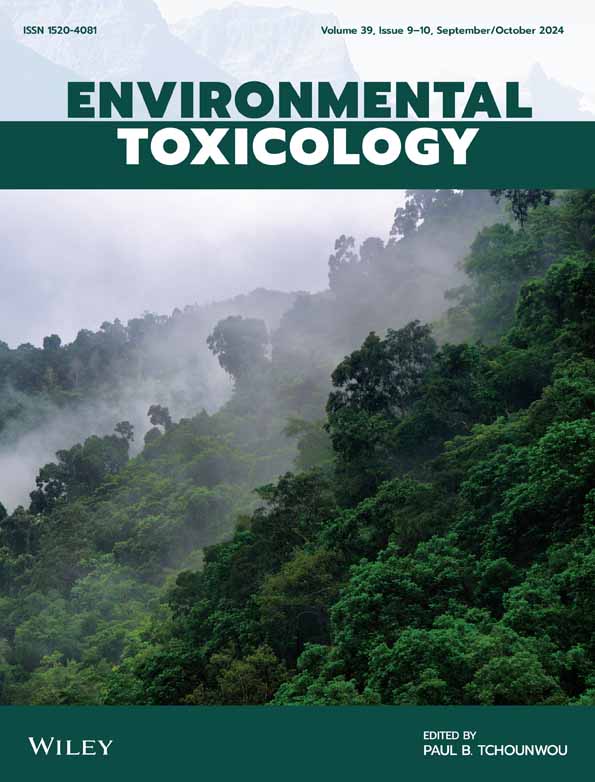亚致死暴露于毒死蜱-氯氰菊酯混合物会破坏家禽胚胎的肢体发育并导致严重的骨骼异常。
IF 3.2
3区 医学
Q2 ENVIRONMENTAL SCIENCES
引用次数: 0
摘要
本研究考察了含有50%毒死蜱(CP)和5%氯氰菊酯(CM)的亚致死剂量(0.1 ppm)的组合杀虫剂对鸡胚胎肢体发育的致畸作用,揭示了严重的骨骼异常和关键分子途径的中断。第2天观察到早期缺陷,包括体体数量减少和体体图案异常,第10天和第21天出现明显的肢体畸形,如肢体缩短和手指扭曲。x射线分析证实骨骼异常,而阿利新蓝-茜素红染色显示软骨和骨结构畸形。基因和蛋白表达分析显示,Sonic hedgehog基因(SHH)、成纤维细胞生长因子(FGF10、FGF8)和WNT7A显著下调,导致手指形成和肢体伸长受损。HOX基因(HOXA11, HOXD11)最初上调,但随后下调,破坏肢体节段识别。此外,Tbx4和Pitx1的下调导致后肢畸形。CASPASE3的失调会损害细胞凋亡,导致手指分离缺陷。分子对接研究表明,CP和CM与SHH、FGF10、WNT7A和HOX蛋白具有很强的结合亲和性,表明它们可能干扰这些信号通路。值得注意的是,对肢体形成至关重要的SHH-FGF-WNT轴的破坏是这些缺陷的关键驱动因素。生化分析进一步显示羟基脯氨酸含量降低,表明胶原合成受损。这些发现强调了SHH、FGF、WNT、HOX、Tbx4和Pitx1通路的严重破坏,强调了需要更严格的农药法规来预防先天性肢体畸形。本文章由计算机程序翻译,如有差异,请以英文原文为准。
Sublethal Exposure to a Chlorpyrifos-Cypermethrin Mixture Disrupts Limb Development and Causes Severe Skeletal Abnormalities in Domestic Chick Embryos.
This study examines the teratogenic effects of a sublethal dose (0.1 ppm) of a combination insecticide containing 50% chlorpyrifos (CP) and 5% cypermethrin (CM) on chick embryo limb development, revealing severe skeletal abnormalities and disruptions in key molecular pathways. Early-stage defects, including reduced somite numbers and abnormal somite patterning, were observed by day 2, with prominent limb deformities, such as limb shortening and twisted digits, emerging by days 10 and 21. X-ray analysis confirmed skeletal anomalies, while Alcian blue-Alizarin red staining revealed malformed cartilage and bone structures. Gene and protein expression analyses showed significant downregulation of Sonic hedgehog (SHH), Fibroblast Growth Factors (FGF10, FGF8), and WNT7A, leading to impaired digit formation and limb elongation. HOX genes (HOXA11, HOXD11) were initially upregulated but later downregulated, disrupting limb segment identity. Additionally, downregulation of Tbx4 and Pitx1 contributed to hindlimb malformations. Dysregulation of CASPASE3 impaired apoptosis, resulting in defective digit separation. Molecular docking studies indicated strong binding affinities of CP and CM to SHH, FGF10, WNT7A, and HOX proteins, suggesting interference with these signaling pathways. Notably, the disruption of the SHH-FGF-WNT axis, essential for limb patterning, was a key driver of these defects. Biochemical assays further revealed reduced hydroxyproline content, indicating impaired collagen synthesis. These findings highlight severe disruptions in SHH, FGF, WNT, HOX, Tbx4, and Pitx1 pathways, emphasizing the need for stricter pesticide regulations to prevent congenital limb malformations.
求助全文
通过发布文献求助,成功后即可免费获取论文全文。
去求助
来源期刊

Environmental Toxicology
环境科学-毒理学
CiteScore
7.10
自引率
8.90%
发文量
261
审稿时长
4.5 months
期刊介绍:
The journal publishes in the areas of toxicity and toxicology of environmental pollutants in air, dust, sediment, soil and water, and natural toxins in the environment.Of particular interest are:
Toxic or biologically disruptive impacts of anthropogenic chemicals such as pharmaceuticals, industrial organics, agricultural chemicals, and by-products such as chlorinated compounds from water disinfection and waste incineration;
Natural toxins and their impacts;
Biotransformation and metabolism of toxigenic compounds, food chains for toxin accumulation or biodegradation;
Assays of toxicity, endocrine disruption, mutagenicity, carcinogenicity, ecosystem impact and health hazard;
Environmental and public health risk assessment, environmental guidelines, environmental policy for toxicants.
 求助内容:
求助内容: 应助结果提醒方式:
应助结果提醒方式:


